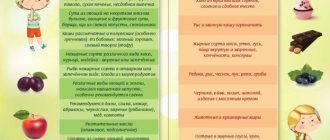Principles and rules of diet for children
When starting to create a menu for a child, you need to adhere to a number of rules. They will make the diet as effective as possible.
- A child needs vitamins, minerals and other useful substances, which he can only get from food. It is important that the menu is not devoid of fats, proteins and carbohydrates. Deficiency of nutrients is unacceptable.
- A child should not experience hunger that is unacceptable to him.
- A child should not be allowed to be completely deprived of sweets, despite the fact that he is on a diet. However, they should be useful.
- A children's diet cannot be strict. This is contrary to all medical principles. There are no indications for a strict diet for children.
The principles on which any children's diet is built:
- A balanced menu, with an emphasis on protein products. They should be at least 50% in the daily diet.
- Compliance with the caloric content of dishes according to the age characteristics of the body.
- Lack of foods on the menu that contribute to weight gain.
In addition to all of the above principles and rules for creating a children's diet, it is also necessary to take into account the following recommendations:
- You need to eat 5-6 times a day.
- During the day you need to distribute products correctly:
- At breakfast, the child should eat 25% of the daily diet.
- During lunch – 10%.
- Lunch accounts for 40%.
- For afternoon tea – 5%.
- At dinner he eats 20% of the entire menu offered.
- Before lunch, the menu should be dominated by protein products, and in the evening - vegetables and cereals.
- You can’t eat a lot without following a regimen.
- Children should eat foods that are gently cooked. You can steam, bake, stew and boil.
If there are no medical indications, then a child under 5 years of age cannot be allowed to follow a diet. Limiting the food supply can lead to a failure in the absorption of nutrients, disrupt metabolism, and therefore provoke excess body weight gain. A young child should eat properly and should not be offered unhealthy foods or sweet carbonated water.
General rules for preparing dietary dishes for children
These rules will be useful for both adults and anyone who wants to stay healthy. The following are not used in preparing dietary dishes for children:
- ready-made sauces - mayonnaise, ketchup and soy; they may contain too much salt, preservatives and substances that irritate the mucous membrane of the digestive organs;
- Your child should not cook from canned food or semi-finished products; chicken breasts, fish fillets and other prepared foods that have not been treated with chemicals are allowed. It is best if the dishes are prepared from meat and fish that have not yet been frozen;
- Margarine and frying fat substitutes must be completely excluded from the diet. You shouldn't get carried away with sugar either. Fructose and honey are recommended for baby food (if there are no allergies). Questions about the use of stevia and erythrol should be discussed with your pediatrician. In any case, some of the sugar can be replaced with natural products such as dates and bananas.
Dietary dishes at the common table for children 1-3 years old are prepared from natural products; the calorie content of the food is not deliberately limited. The recipes that will be given below are taken from the manual on organizing children's meals at tables number 15 and 16 (these are common tables for healthy children).
Permitted and prohibited products
Products that are allowed to be eaten during the children's diet:
- Meat: beef, rabbit, turkey, nutria, chicken, offal, homemade liver pate.
- Chicken eggs, quail eggs.
- Cereals: oatmeal, buckwheat, rice, millet, pearl barley, corn grits.
- Legumes, vegetables, greens.
- Milk and fermented milk drinks and products.
- Berries and fruits.
- Rye bread, bran bread.
- Fresh juices made from fresh fruits, nectars, fruit drinks, jelly, uzvar, cocoa, green tea, herbal decoction, rosehip infusion, still mineral water.
Products that a child can consume in limited quantities:
- Chocolate, marmalade and marshmallows.
- Vegetable oil used for salad dressing.
- You can add butter to porridge.
Sweet foods should be given to the child in the first half of the day and in small quantities.
Products that are prohibited from using when compiling a children's menu:
- Smoked meats.
- Canned food.
- Baked goods, sparkling water.
- Semi-finished products.
- Sausages.
- Fast food.
- Fried pies.
- Crackers, nuts and chips.
What else you need to know about diet for obesity in children
- For any degree of obesity, a child of any age is first prescribed a diet that corresponds to his physiological standards - this diet will already have certain restrictions for the child, since in most cases overweight children have an increased appetite and transmit.
- If weight gain stops on this diet, this is a positive effect of diet therapy and after an adaptation period you can switch to a more strict diet in order to gradually reduce and eliminate excess weight.
- The main task of the adaptation period is the correct diet (emphasis on taking the main share of food and its caloric intake in the first half of the day and refusing to eat after 18-19 hours.
- During the adaptation period, there is no need to insist on a significant reduction in “junk” foods (flour and sweets).
It is important to realize one point - you should not “chase” rapid weight loss, you first need to achieve compliance with the above-described standards, the child’s adaptation, and only then move on to a subcalorie diet.
At the same time, with 1 degree of obesity, the introduction of diet therapy begins with a transfer to physiological regimes and nutritional standards, the adaptation period lasts 1-3 months, increased appetite can be balanced by eating food rich in fiber, but low in calories (vegetables). It is necessary to adhere to the norms of the “food traffic light” rule and increase the child’s physical activity. This is often enough to normalize and maintain weight at normal age levels.
In children with degree 2 obesity, upon completion of the adaptation period, a physiological diet is prescribed (based on the quality, quantity and nature of the daily diet); after 2 - 3 months, a subcalorie diet is gradually introduced.
For grade 3 and 4 obesity:
- adaptation period;
- compliance with physiological nutritional standards for 4 - 6 months;
- transfer to a subcalorie diet - SC 1 - SC 2 - SC 3 (sequentially).
A good motivation for children and adolescents is understanding and support from the family; for example, it is important to create a spirit of competition - which member of the household will lose weight faster and to a greater extent. In this case, the rate of weight loss in a child should not exceed 10-15% of the initial value over 3-6 months of treatment.
All obese patients are required to attend anti-obesity schools.
It must be remembered that diets with an energy value of less than 1200 kcal/day in obese patients are perceived by the body as hunger.
Undesirable effects of very low-calorie diets are described: weakness, fatigue, hair loss, constipation, diarrhea, dry skin, nausea, dysmenorrhea, amenorrhea, hunger intolerance, heart rhythm disturbances, the development of gout, cholelithiasis, cardiovascular disease, osteoporosis and various metabolic disorders substances.
This is due to the huge number of diets that limit calorie intake to 400-600-800 kcal/day, this is especially important for teenage children - parents should monitor what dietary restrictions the child uses and how this will then affect his condition/ her future health.
The diet should be selected and monitored by an endocrinologist or nutritionist, under the control of changes in weight and laboratory parameters.
Post Views: 2,432
Sample menu for a week's diet for children
The proposed menu is balanced. It allows you to lose 1 kg of weight in a week, and there will be no harm to children’s health. During the diet, it is important to ensure that the child drinks enough water and also engages in physical activity.
| Diet day | Breakfast | Snack | Dinner | Dinner |
| 1 | Steam omelet based on 1 egg, skim milk and rice, fresh apple | Wholemeal toast with butter, low-fat cheese, cucumber, compote with dried fruits | Steamed potatoes, steamed chicken liver, greens, fresh carrots | Muesli, salad with boiled beets and walnuts with sour cream dressing, cocoa |
| 2 | Pancakes with semolina, apple, green tea with lemon | Greek salad, boiled egg, fresh orange | Soup with meatballs and buckwheat, whole grain toast | Cabbage-carrot salad with grated apple and sour cream, fruit jelly |
| 3 | Salad with boiled rice, egg and squid, pomegranate juice | Steamed fish balls, milkshake with strawberries and bananas | Fish soup, stewed cabbage with chicken hearts, berry juice | Rice porridge with raisins, fruit salad with yogurt, orange juice |
| 4 | Steam omelette with mushrooms, chicken fillet and celery, whole grain toast, green tea | Cottage cheese with fruit | Borscht with chicken, vinaigrette, fresh apple | Muesli, berry jelly and pear |
| 5 | Pumpkin porridge and uzvar | Baked apple, berries | Green borscht with beef, salad with fresh vegetables, orange juice | Corn porridge with raisins, yogurt |
Potato casserole with vegetables and cheese
A simple and satisfying everyday dish suitable for children and adults.
You will need:
1 kg of potatoes, 3 eggs, 100 g of hard cheese, 200 g of vegetable mixture, 100 ml of milk.
Preparation:
Boil the potatoes until tender, grate the cheese and beat the eggs with salt. Beat these ingredients with a blender until smooth and add lightly fried vegetables. Knead the potato dough, place in a mold and bake for 25 minutes at 180 degrees.
Delicious recipes
Pilaf with dried fruits
- You can take any dried fruit in a volume of 150 g. This can be prunes, dates, dried apricots or raisins. You will also need 0.3 kg of nuts - cashews, almonds or walnuts.
- Rice should be long grain, its volume is 0.7 kg. Soak the rice for an hour in salted hot water.
- When the rice can be easily crushed with your fingernail, it is ready for further processing. If the cereal is too hard, then drain the water and pour boiling water over the rice again.
- While the rice is being prepared, finely chop the carrots and cut the onions into feathers.
- Onions are fried in vegetable oil until golden brown.
- Carrots are fried in butter.
- Place onions, rice, carrots in a cauldron, fill with water so that its level rises one finger above the rice. Salt the dish, add barberry and cumin.
- Do not cover the cauldron; cook the pilaf over high heat until all the liquid has evaporated.
- Dried fruits and nuts are fried in a frying pan with butter, placed in a cauldron with rice and covered with waffle towels and then with a lid.
- After 30 minutes the pilaf will be ready, it needs to be mixed and served.
Minestrone
- Finely chop the red onion and garlic clove.
- Cut 2 carrots, 2 celery trunks, a fennel tuber, 1 potato into cubes.
- Divide the leek into 2 halves, wash it thoroughly and cut it into slices 1 cm thick.
- Using a blender, grind 0.8 kg of canned tomatoes in their own juice.
- Fry zucchini, leeks, garlic, carrots, celery, and 1/4 teaspoon of dried oregano in olive oil. Then cover with a lid and simmer for another 15 minutes.
- Add potatoes, tomatoes and vegetable broth in an amount of 1 liter to the vegetables.
- Cook the soup for another 30 minutes.
- Cut 1 tomato, 1 zucchini and 1 sweet pepper into cubes, add them to the soup 10 minutes before the end of cooking. Along with the vegetables, add a can of canned beans to the dish.
- The soup is salted and peppered, served with basil leaves and grated Parmesan.
Soufflé with rabbit meat
- Boil 0.2 kg of rabbit meat.
- Soak 80 g of white bread crumb in milk.
- The meat and bread are passed through a blender, 4 chicken eggs are added to it and ground again.
- Fill muffin tins with minced meat and place on a baking sheet with water.
- Bake in the oven for a quarter of an hour at a temperature of 180 °C.
- Soufflé is eaten both hot and cold.
Fish quenelles
- Grind 0.35 fillets of low-fat white fish in a meat grinder.
- Dry the flour (2 teaspoons) in a frying pan, pour milk into the frying pan, stirring constantly so that no lumps form, and add salt.
- Add this sauce to minced fish. The yolk and separately beaten white are introduced there.
- Form the minced meat into balls and cook them until fully cooked.
- Separately, prepare the sauce for the quenelles: peel the peaches, remove their pits, and fry the onions with garlic and dried paprika in olive oil. After 5-8 minutes, add 3 tablespoons of lemon juice, 2 tablespoons of sugar to the onion, salt and pepper, fry for another 5 minutes, then add peaches to the pan and cook for 5-10 minutes. If the sauce turns out to be very thick, it can be diluted with water.
- When the sauce is ready, it is passed through a blender and served with the quenelles.
Soba noodle soup
- Soak 2 sheets of dried seaweed in 4 glasses of cold water for 20 minutes, boil the water and reduce the heat.
- Add 30 g of fish chips to the pan, cook for a few more minutes, strain the broth through cheesecloth.
- Separately, boil the soba noodles, following the instructions on the package, and rinse the finished noodles in cold water.
- Boil the eggs and peel them.
- Chopped champignons, a bunch of bok choy, and shrimp are added to the boiling broth left over from the seaweed.
- Place soba noodles on a plate, an egg cut into 2 parts, pour in broth, add bok choy.
- Garnish the soup with sesame seeds and green onions.
Three recipes for children's lunch
Chicken meatballs
Ingredients:
- 1 chicken breast;
- 2 onions;
- tomato paste;
- 1 bell pepper;
- 1 carrot.
Grind the fillet with 1 onion in a meat grinder. Form balls the size of eggs. Fry in a small amount of vegetable oil for literally 2-3 minutes until browned. Finely chop the onion and bell pepper, grate the carrots. Simmer the vegetables, add tomato paste, dilute with water. Place the meatballs in a heat-resistant bowl, pour in tomato sauce, place in the oven preheated to 1800C for 20-25 minutes.
chicken meatballs
Chicken and cauliflower soup
Ingredients:
- 200-300 g chicken fillet;
- 1 onion;
- 1 carrot;
- 200-300 g cauliflower.
Boil the chicken fillet for 5-10 minutes, drain the water. Pour in clean water and bring to a boil again. Add carrots, cut into slices, and a whole onion. Separate the cabbage into florets, chop if necessary, and add to the soup. Bring to readiness, the onion can be caught. Salt and pepper to taste.
chicken and cauliflower soup
Lentil soup
Ingredients:
- 1 onion;
- 1 carrot;
- 2 cups lentils;
- 1 tbsp. tomato paste;
- 2-3 tomatoes;
- 2 tbsp. grated ginger root;
- olive oil.
Rinse the lentils, add water or vegetable broth, and put on fire. Fry onions and carrots in olive oil for 5 minutes, add tomato paste, spices, tomatoes, add water if necessary. Simmer for another 10 minutes, add to the broth with lentils and cook for another 30-35 minutes.
Therapeutic diets for children
Diet for children with allergies
If a child suffers from allergies grows up in a family, then he needs to follow a certain diet. Otherwise, the baby will be plagued by such health problems as: urticaria, allergic rhinitis, diathesis, conjunctivitis.
However, despite the fact that the child needs to adhere to dietary nutrition, his diet must be complete. Parents should definitely know which foods are more allergenic and which are less allergenic.
Thus, the products that most often cause allergic reactions include: eggs and milk, citrus fruits, berries (raspberries, strawberries, strawberries), wheat and rye, chocolate, coffee, honey, cocoa, nuts.
Products that have an average allergenic potential: potatoes, legumes, beets, apricots, peaches, bananas, blueberries, black currants.
The menu of a child with allergies should be based on products such as:
- Fermented milk drinks and products.
- Meat: low-fat pork, lamb, turkey, rabbit, horse meat.
- Green apples and pears.
- Dill and parsley.
- White and cauliflower cabbage, cucumbers and zucchini, yellow cherries.
The products on this list have minimal allergenic potential, so they can be offered to a child with allergies.
Read more: Diet for allergies
For rotavirus infection
Rotavirus infection (intestinal flu) is a disease that can affect not only children, but also adults. However, it is young children who are most often infected. Intestinal flu is indicated by symptoms such as: disturbances in the functioning of the digestive system (diarrhea, vomiting, abdominal pain), high body temperature.
Rules for feeding a child with rotavirus infection:
- It is important to ensure that your child does not become dehydrated. To normalize the electrolyte balance, the baby is offered Regidron, but often children refuse to take it because it has a specific taste. Therefore, you need to give your child as much water as possible, weak tea, you can drink compote, decoctions of mint and chamomile.
- If the child does not ask to eat, then there is no need to force him. The main thing is that he drinks enough.
- You need to drink in small portions so as not to provoke vomiting.
In the first 2-3 days, every effort should be made to normalize the child’s stool. Therefore, you can offer him lean rice porridge and stewed apples.
In the future, the menu will be expanded to include the following products:
- Biscuits, crackers.
- Vegetable broth. Fish and meat broth is only low-fat; for this, after boiling, drain the water, pour in clean broth and continue to cook the food.
- Soup with cereals that must be thoroughly boiled.
- Steam omelette.
- Steamed chicken or turkey cutlets, boiled fish fillet. You can use fish such as pollock, cod and hake.
- Mashed potatoes. No oil is added to it.
After 3-4 days from stool normalization, fermented milk drinks can be introduced into the child’s diet. Any products that could provoke disturbances in the functioning of the digestive system should be removed from the menu. You should not give your child milk, cheese, sugar, honey, brown bread, pastries, pasta, dumplings, dumplings, legumes, fatty fish and meat, sausage, smoked products, chocolate, cocoa, coffee, strong black tea.
Only after 10 days can you transfer the child to the usual menu. Until all the symptoms of rotavirus infection are eliminated, he must adhere to a diet.
Read more: Intestinal infection in children: what to do?
When vomiting
If a child is vomiting, he will lose a lot of fluid. As temperatures rise, the situation is getting worse. During the first day the baby is not fed, but he must be given water frequently. You can give herbal tea, rosehip decoction, unsweetened mineral water without carbon. The child should drink in small portions, but as often as possible.
When the vomiting stops, you need to start feeding the baby. You should follow a gentle diet. Products that should be excluded from the menu:
- Fried foods.
- Fresh fruits and vegetables, natural juices.
- Oils: butter and sunflower.
- Sausages and smoked products.
- Rolls, confectionery, sweets and baked goods.
- Sparkling water.
- Yachka, pearl barley and millet.
In order for the gastrointestinal tract to recover faster, the menu should be based on foods that are easily digestible:
- Baked apples.
- Bananas.
- Compote with dried fruits and rosehip decoction.
- Boiled grated vegetables. Preference should be given to carrots and apples.
All dishes must be warm. Food that is too hot or too cold will irritate the stomach and slow down the healing process.
Read more: Vomiting in a child without fever and without diarrhea
For urticaria
For urticaria, the child’s menu should be based on hypoallergenic products. At the age of up to 1.5 years, the child’s nutrition should be “rejuvenated”, that is, if an allergic reaction occurs, his menu is transferred back to the previous level. This must be done until a complete recovery occurs.
The following foods are removed from the diet:
- Citrus.
- Chocolate and all products containing cocoa.
- Mushrooms.
- Nuts.
- Products that have undergone a smoking process.
For urticaria, a child can receive the following foods:
- Fermented milk drinks and low-fat products: kefir, sour cream, yogurt, cottage cheese. It is important to purchase only natural products that do not contain dyes, additives or preservatives.
- Cereals: corn, rice, buckwheat. You need to cook porridge in water.
- Boiled meat: beef, poultry. It is important to choose lean meats.
- Baked vegetables and apples.
- Vegetable soups.
- Green apples, pears, grapes.
In addition to the fact that the child is brought to a specialized menu, he must receive drug therapy. Only a doctor can prescribe treatment. If you ignore taking medications, urticaria will become chronic.
Read more: Urticaria - causes and symptoms
For atopic dermatitis
Atopic dermatitis requires avoiding eating foods that contain dyes and food additives. If it has been established which food components lead to an allergic reaction, they must be discarded. Provided that the baby is fed breast milk, the nursing mother should monitor her menu with special care.
The baby should eat according to the diet, but he should not be overfed.
Products that may be present on the child's menu:
- Dairy products. You can offer your child one-day kefir.
- Porridges that do not contain gluten: rice, corn, buckwheat.
- Vegetable soups, broths based on beef tenderloin.
- Baked apples.
- Boiled potatoes.
- Black bread,
- Dill and parsley.
Doctors strongly recommend removing all baked goods from the child’s menu. On an industrial scale, margarine is used for their production, which is strictly prohibited for consumption in this form of dermatitis.
Read more: Atopic dermatitis in adults and children
For pyelonephritis
Treatment of pyelonephritis is aimed at removing intoxication from the body. Therefore, the child should receive as much fluid as possible. It is allowed to give him fruit drinks, compotes, herbal decoctions, weakly brewed black tea, infusions of rose hips, rowan and black currant.
You should also include fruits and vegetables in your child’s diet, which have a diuretic effect. These can be zucchini, melons and watermelons.
You can offer your child dairy products, confectionery, cereals, sugar, and dried fruits.
The following are prohibited:
- Smoked products.
- Coffee and cocoa.
- Chocolate.
- Fried foods.
- Spices and seasonings.
- Spinach and cauliflower.
- Mushrooms.
- Meat and fish, as well as broths prepared on their basis.
Gluten-free diet
A gluten-free diet requires avoiding all foods that contain gluten - oats, rye, wheat, barley. Children with autism must adhere to a menu that does not contain gluten-containing grains.
There is also a ban on chocolate and any baked goods. When a child enters kindergarten, parents must notify its management about the existing problem.
Read more: List of gluten-free and gluten-containing products
Features of the child's body
A child's nutrition depends on his age. Babies consume mother's milk. It has the most balanced composition and contains all the necessary substances for the growth and development of a newborn. If the mother does not have enough milk, from the first days of life, children are fed special formulas that undergo strict quality control and contain all the necessary nutritional compounds.
To prevent a child from developing health problems and excess weight, his diet must be properly balanced.
Starting from 5 months, special complementary foods made from seasonal vegetables and fruits are used. They are a good addition to breast milk. Starting from the age of one year, the child can be given vegetables, fruits, meat, dairy products and cereals. During this period, children grow quickly, so if they require a diet, it is only as an auxiliary method of treatment.
Starting from the age of 3-4 years, a child develops taste preferences. He may become addicted to sweets and fast food. It is extremely important that parents monitor the quality of food. Nutrient deficiency during this period causes a slowdown in mental and physical development.
An excess of high-calorie foods provokes obesity in children over 5-7 years old. If measures are not taken, the situation will worsen in the future.
It is extremely important that your child’s diet includes healthy and tasty foods. They must meet the needs of the child’s body for proteins, fats and carbohydrates, and also contain a sufficient amount of vitamins and minerals.
Basic principles of children's diet
Only in the period from birth to the first complementary feeding is there completely no risk of becoming obese.
This is the moment when the baby receives all the necessary microelements through mother's milk. The introduction of complementary foods seriously affects the weight of children. This is explained by the fact that mothers try to feed the baby more and finish breastfeeding faster. This leads to an increased risk of obesity. Taking into account the fact that the children's body differs in the functioning of all systems, it is prohibited to use an adult diet. Special dietary food is required for children. It is based on the following principles:
- Balanced diet. It consists of a competent combination of protein foods and nutrients.
- Fractional meals. Children's age matters. One-year-old babies should eat every 2-2.5 hours, from one year to 2 - 4 times, from 2 to 3 - 5 times, after 3 years of age - 5-6 times a day.
- Calorie content. You can calculate using tables based on the child’s age.
- The evening meal should consist of low-calorie foods.
- No feeling of hunger.
- Compliance with drinking regime. There are no specific recommendations for the amount of fluid consumed, but 1-2 glasses should be drunk in the morning on an empty stomach, half an hour before meals, before taking vitamins or physical activity.
- Motivation. Often, a diet for an overweight child is an almost insurmountable obstacle. The peculiarity of the children's psyche is that they do not accept any coercion. The best way to motivate a child to lose weight is for all family members to adhere to the principles of proper nutrition.
- Support. It is necessary to resort to encouragement after achieving a certain result.
- Physical exercise. The effectiveness of the diet will depend on the physical activity of children. You can enroll in a section, if you have no inclination towards sports, use outdoor games, be sure to do morning exercises.
Important: the diet menu for children does not provide for the constant use of vitamin complexes. With proper nutrition, the child’s body receives the right amount of nutrients. More frequent use of vitamins is necessary to strengthen the immune system. You need to understand that following a diet and taking vitamins are two different things.
Contraindications to the diet
The use of children's diet food for weight loss is strictly prohibited under 5 years of age. Until this time, the child is taught to eat healthy foods. Starting from 6 years of age, if you are overweight, you must consult a doctor to rule out the occurrence of other diseases. Common contraindications for weight loss:
- diseases of the gastrointestinal tract;
- type 1 diabetes mellitus;
- benign or malignant neoplasms;
- diseases of the cardiovascular system;
- allergy to dairy products.











